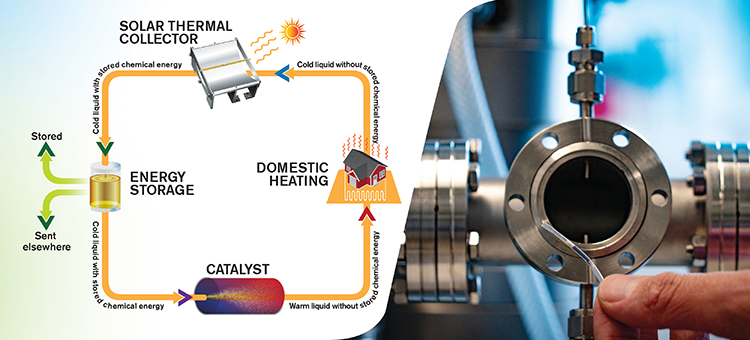Oct 6 2020
In the past few years, a team of researchers from the Chalmers University of Technology in Sweden has designed a uniquely engineered molecule and an energy system with innovative abilities for trapping and storing solar power.
 The specially designed molecule and energy system by the researchers from Chalmers has demonstrated unique abilities to catch and store solar energy. The image to the right shows a tube with the catalyst inside, in front of a vacuum set-up used to measure the rise of the temperature in the energy storage system. Image Credit: Yen Strandqvist/Johan Bodell/Chalmers University of Technology.
The specially designed molecule and energy system by the researchers from Chalmers has demonstrated unique abilities to catch and store solar energy. The image to the right shows a tube with the catalyst inside, in front of a vacuum set-up used to measure the rise of the temperature in the energy storage system. Image Credit: Yen Strandqvist/Johan Bodell/Chalmers University of Technology.
Currently, an EU project headed by Chalmers will create prototypes of the new technology for mass applications, like heating systems in residential homes. The EU has awarded a grant worth 4.3 million Euros for the project.
To make complete use of solar energy, it must be possible to store and release the energy on demand. In a number of scientific articles spanning the last few years, a team of scientists from the Chalmers University of Technology has shown how their specially engineered molecule and solar energy system, called Molecular Solar Thermal Energy Storage System (MOST), can deliver a solution to meet that challenge and become an important tool in the transition to fossil-free energy.
Globally, the technology has attracted immense interest. The MOST system can be used to trap and store solar energy for nearly 18 years, conveyed without any big losses, and later discharged as heat when and where it is required. The results accomplished in the lab by the team are comprehensible. However, at present, more experience is required to see how MOST can be employed in everyday applications and on a mass scale.
The goal for this EU-project is to develop prototypes of MOST technology to verify potential for large-scale production, and to improve functionality of the system.
Kasper Moth-Poulsen, Project Coordinator, Professor, and Research Leader, Department for Chemistry and Chemical Engineering, Chalmers University of Technology
Pushing Toward Products for Real Applications
As part of the project, the efficiency of the technology will be further advanced, and ways to make the technology less expensive and greener will be looked into, thus pushing toward products that can be utilized in daily applications. Robust research teams from universities and institutes in Sweden, the United Kingdom, Spain, Denmark, and Germany will unite and work together.
A very exciting aspect of the project is how we are combining excellent interdisciplinary research in molecule design along with knowledge in hybrid technology for energy capture, heat-release and low-energy building design.
Kasper Moth-Poulsen, Project Coordinator, Professor, and Research Leader, Department for Chemistry and Chemical Engineering, Chalmers University of Technology
Using the Molecule in Blinds and Windows
Improvements in the development of MOST technology have thus far surpassed all anticipations. The first, very basic—yet successful—trials happened in Chalmers’ laboratories. Besides other things, the technology has been used by the team in a window film to balance out the temperature on hot and sunny days and create a more agreeable indoor environment.
Beyond the EU project, the application of the molecule in windows and blinds has started, via the spin-off company Solartes AB.
With this funding, the development we can now do in the MOST project may lead to new solar driven and emissions-free solutions for heating in residential and industrial applications. This project is heading into a very important and exciting stage.
Kasper Moth-Poulsen, Project Coordinator, Professor, and Research Leader, Department for Chemistry and Chemical Engineering, Chalmers University of Technology
More About the Function of the MOST Technology
The technology is based on a specifically engineered molecule, which when struck by sunlight alters shape into an energy-rich isomer—a molecule composed of the same atoms but set together in a diverse way. The isomer can then be stored for future use when required, such as in winter or at night.
The team has so far developed the system where it is currently possible to store the energy for up to 18 years. A specially engineered catalyst discharges the saved energy as heat while returning the molecule to its former shape, which enables it to be used again in the heating system.
More About the EU Project
The EU project, which is also known as “Molecular Solar Thermal Energy Storage Systems,” will spread over 3.5 years and has been sanctioned 4.3 million Euros.
Project partners include the Chalmers University of Technology, University of Copenhagen, University of Rioja, Fraunhofer Institute, ZAE Bayern, and Johnson Matthey. At Chalmers, scientists from the Department of Chemistry and Chemical Engineering and the Department of Architecture and Civil Engineering will take part.